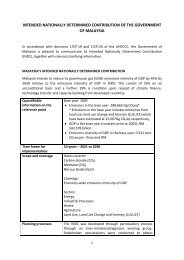RP-01638
RP-01638
RP-01638
You also want an ePaper? Increase the reach of your titles
YUMPU automatically turns print PDFs into web optimized ePapers that Google loves.
ol<br />
inch<br />
1<br />
cm<br />
Fig. 7. Third modification of PVC foot valve: (1) threaded<br />
boit; (2) stainless-steel plate; (3) PVC lining and steel<br />
casing; (4) 7/16-inch (1.11-cm) holes on 1.5-inch (3.8-cm)<br />
pitch diameter; (5) brass guide; (6) rubber plate valve; (7)<br />
steel cap; and (8) O-ring.<br />
three regions that were selected were<br />
located in the following areas: (1) Saraburi<br />
and Lopburi provinces, central Thailand;<br />
(2) Khon Kaen province, northeastern<br />
Thailand; (3) Lamphun and Chiang Mai<br />
province, northern Thailand.<br />
In each region, 18 wells having different<br />
characteristics were equipped with the<br />
modified PVC cylinders, pistons, and foot<br />
valves. One important factor that was<br />
considered in well selection was to choose a<br />
well with a high frequency of usage, because<br />
many wells are rarely used in some areas.<br />
Another factor that was considered was the<br />
existence of an access road to the well. If the<br />
well was too far and difficult to reach, the<br />
monitoring would have become very difficult,<br />
and sometimes impossible, during the rainy<br />
season.<br />
Monitoring<br />
Before the PVC components were installed,<br />
initial measurements were made on three<br />
aspects - above- and below-ground components<br />
and the static water table.<br />
The configuration of the above-ground<br />
component of the handpump was noted and<br />
ail the relevant dimensions of the components<br />
were recorded.<br />
For the below-ground components, the<br />
thickness of the upper and lower polyethylene<br />
rings on the piston was measured using a<br />
micrometer. For each ring, the measurements<br />
were taken at three different positions<br />
10<br />
4<br />
1<br />
2<br />
3<br />
4<br />
5<br />
spaced 120° apart. The diameter of the piston<br />
was noted and the inner diameter of the PVC<br />
cylinder was measured with an internai<br />
vernier caliper. The cylinder and piston<br />
assembly were inspected at roughly 3-month<br />
intervals.<br />
The static water level is the distance from<br />
the surface of water (water table) in the well<br />
to the outlet spout of the pump. This static<br />
water level was measured using an electronic<br />
sound probe. A wire lead from this device is<br />
lowered slowly into the well through a hole<br />
drilled in the pump casing. When the wire<br />
touches the surface of the water, a sound is<br />
produced electronically. The static water level<br />
equals the length of the wire plus the distance<br />
from the hole to the spout of the pump. The<br />
static water level was observed monthly.<br />
After installation of the PVC components,<br />
the performance of the pump was tested by<br />
measuring the actual volume of water discharged<br />
per 10 strokes of piston movement.<br />
These data were also collected on a monthly<br />
basis.<br />
In addition to these tests, samples of the<br />
water from the wells in the three regions were<br />
tested in the laboratory for water quality. The<br />
analyses were conducted by the Environmental<br />
Engineering Division using standard<br />
methods for 10 parameters: pH, turbidity,<br />
colour, hardness, calcium, chloride, nitrate,<br />
manganese, iron, and fecal coliform. The<br />
water quality index was calculated based on<br />
two different approaches: the Delphi Approach<br />
using option 1 and the WHO Alternative<br />
Approach. The test results indicated that, for<br />
some wells, the water quality index was poor<br />
and the water in these locations was recommended<br />
for general domestic uses only and<br />
not for consumption. Normally, the villagers<br />
possessing these wells obtain their drinking<br />
water from open ponds that collect rain water<br />
during the rainy season.<br />
Results of field testing<br />
The fluctuations of static water levels for<br />
wells located in Saraburi and Lopburi, Khon<br />
Kaen and Chiang Mai, and Lamphun with<br />
respect to calendar time were plotted (see,<br />
for example, Fig. 8). The static water level<br />
was rather high during October to December<br />
and low during February to March, which<br />
correspond to the rainy and dry seasons<br />
respectively.<br />
The volumetric efficiencies, volume of<br />
28



